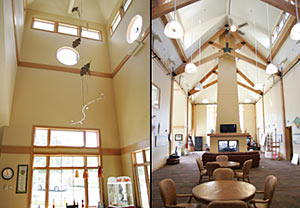Sustainability Rating Systems: Promoting Best Practices and Energy Efficiency
Research and Institutional Facilities
Gregory Bergmiller, LEED AP, project manager at The Slam Collaborative in Glastonbury, Conn., has successfully used the Green Globesâ„¢ rating system for several projects, including a pharmaceutical research facility, and is pleased with the process and the results. "This system provides a holistic project approach and covers a wider scope. Unlike other systems, it's not just yes or no, but offers a percentage based on how many things you do, such as how well you work with a team. The project management section is very effective, as is site assessment. Green Globesâ„¢ gives credit for sites enhancements, such as berms, and addressing wind load. You don't get penalized for doing things under this system," he says.
Green Globesâ„¢ offers an instant, automated online response, withrecommendations on next steps. Bergmiller cites this fast and simple process as a clear benefit: "Feedback from other well known rating system is slow. We have waited two months or more to get a response, and there is little interaction. Our clients like immediate updates. Some clients avoid these systems because of the amount of paperwork, time-consuming activities, and high costs involved. There is often a lot of extra work and clients typically don't pay additional fees, or soft costs, to cover this. Clients resist hiring a project manager to do the extra work, and may try to shift the tasks to the contractor, who may not be inclined to follow up."
Health care facilities and laboratories are two building types that are increasingly addressing sustainability. Some organizations have established their own guidelines, to be applied on a voluntary basis, using existing rating system templates, without offering points. "Even without formal verification, these voluntary modules provide strategies to move market segments toward greater sustainable practices," Bergmiller adds.
Blakely Hall Receives First U.S. Green GlobesTM Rating
Continuing a longstanding commitment to environmental stewardship, Issaquah, Washington was the first U.S. city to have a building certified under the Green Globesâ„¢ environmental assessment and rating system.The Blakely Hall community center achieved two Globes by incorporating several green attributes, such as high energy and water efficiency, integration of daylighting, and use of locally sourced materials. The implementation of a construction waste management plan also helped divert more than 97 percent of waste from landfill.
|
Other green features include an innovative storm water management system, which is part of a larger plan created by Port Blakely Communities to control surface flow in the 2,200-acre Issaquah Highlands Community. With the local population expected to grow substantially, the plan incorporates a comprehensive system of retention ponds, filtration devices, and water control monitors to ensure that ground water is continually replenished, and without any net increase in water flows to streams. Completed in 2005, the two-story, 7,000 square foot community center houses the Issaquah Highlands Council and public spaces.










